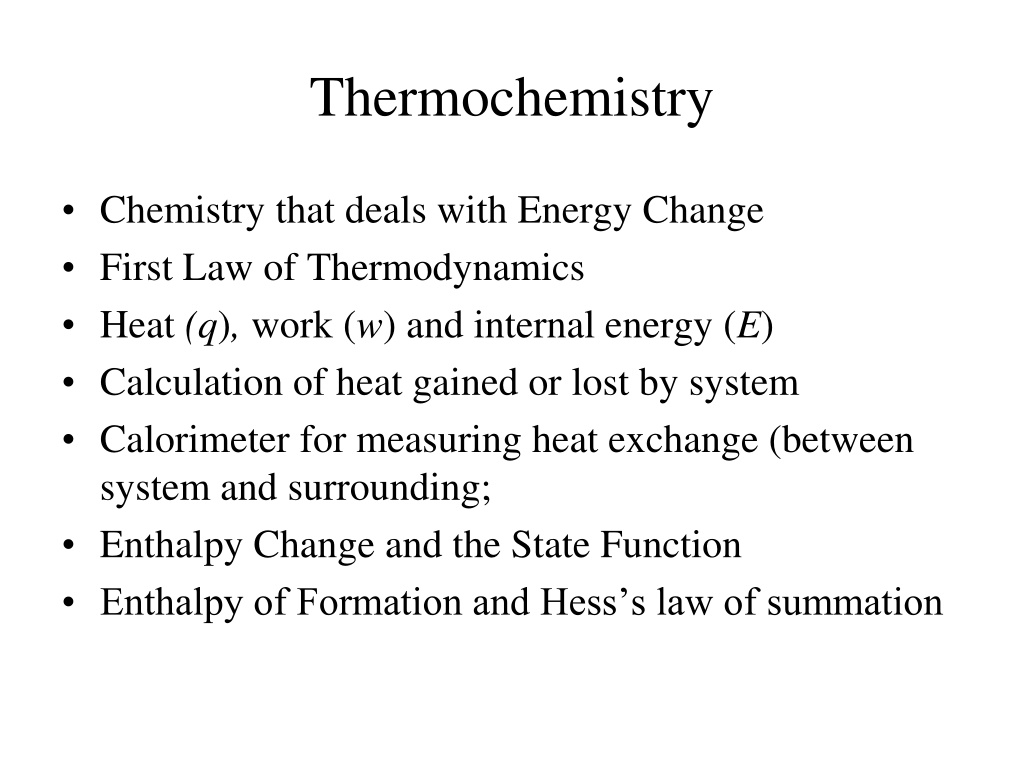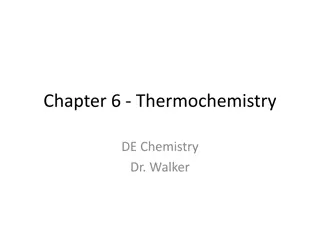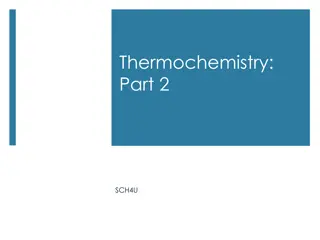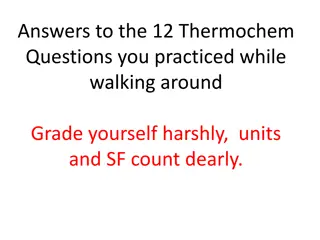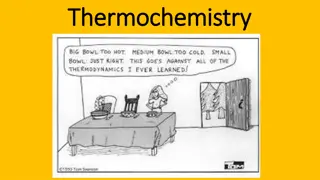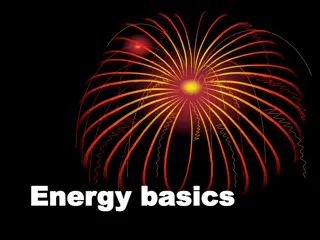Basics of Thermochemistry and Energy Changes in Chemistry
Thermochemistry in chemistry involves energy change, the First Law of Thermodynamics, and concepts like heat, work, and internal energy. It explores calculations of heat exchange using calorimeters, Enthalpy Change, Enthalpy of Formation, and more. Energy basics cover the importance of energy changes in chemical reactions and physical processes, such as metabolism, electricity generation, and powering vehicles. The interconvertibility of energy forms and the Law of Conservation of Energy are fundamental principles in understanding energy transformations.
Download Presentation

Please find below an Image/Link to download the presentation.
The content on the website is provided AS IS for your information and personal use only. It may not be sold, licensed, or shared on other websites without obtaining consent from the author. Download presentation by click this link. If you encounter any issues during the download, it is possible that the publisher has removed the file from their server.
E N D
Presentation Transcript
Thermochemistry Chemistry that deals with Energy Change First Law of Thermodynamics Heat (q), work (w) and internal energy (E) Calculation of heat gained or lost by system Calorimeter for measuring heat exchange (between system and surrounding; Enthalpy Change and the State Function Enthalpy of Formation and Hess s law of summation
Energy Basics The energy changes that accompany chemical reactions and physical changes are very important to us. The reactions involved in metabolism of food. The reactions involved in generation of electricity. The reactions involved in the powering of our automobiles. Sliding a match head along a rough surface initiates a combustion reaction that produces energy in the form of heat and light. (credit: modification of work by Laszlo Ilyes)
Energy Energy is the capacity to supply heat or do work. There are two forms of energy: Kinetic & Potential Potential energy is the energy possessed by an object by virtue of its position, composition, or condition. Kinetic energy (Ek) is the energy that an object posses because of its motion.
Potential & Kinetic Energy Potential Energy: Ep = -mgh Energy associated with the relative position of a substance in a force field, such as gravity, magnetic, chemical bonds, nuclear force, etc. (m = mass; g = gravitational constant, and h = height) Kinetic Energy:EK = mv2 Energy associated with the translational motion of an object. Kinetic energy depends on the mass and speed of the object. (m = mass; v = velocity or speed)
Potential Energy Potential energy is the energy possessed by an object by virtue of its position, composition, or condition. One important form of potential energy of interest to chemists is Chemical energy. Chemical energy is energy stored within the structural units or chemical bonds in a substance. If the water flows through generators at the bottom of a dam, such as the Hoover Dam shown here, its kinetic energy is converted into electrical energy. (credit a: modification of work by Steve Jurvetson; credit b: modification of work by curimedia /Wikimedia commons) 5
Energy and Energy Changes Energy is interconvertible - One form can be converted to another form. Law of conservation of energy During a chemical or physical change, energy can be neither created nor destroyed, although its form can change. Water that is higher in elevation, for example, at the top of Victoria Falls, has a higher potential energy than water at a lower elevation. As the water falls, some of its potential energy is converted into kinetic energy. (credit a: modification of work by Steve Jurvetson; credit b: modification of work by curimedia /Wikimedia commons) Although energy can assume many forms, the total energy of the universe is constant.
Thermal Energy One form of kinetic energy of particular interest to chemists is called thermal energy or heat; This is the energy associated with the random motion of atoms and molecules in the sample.
Thermal Energy and Temperature Thermal energy Kinetic energy associated with the random motion of atoms and molecules. Temperature A quantitative measure of Hot and Cold . Fast moving molecules High thermal energy Hot Slow moving molecules Low thermal energy Cold Heat (q) The transfer of thermal energy between two bodies at different temperature. Thermochemistry The study of the heat flow during a chemical or physical change.
What do we know about heat? Heat will flow from a hotter object to a colder object. a) Substances H and L are initially at different temperatures, and their atoms have different average kinetic energies. b) When they are put into contact with each other, collisions between the molecules result in the transfer of kinetic (thermal)energy from the hotter to the cooler matter. c)The two objects reach thermal equilibrium when both substances are at the same temperature, and their molecules have the same average kinetic energy.
First Law of Thermodynamics Energy is neither created nor destroyed during chemical or physical processes; The energy change ( E) in a system depends only on heat (q) gained or lost and the work (w) done on or by the system: E = q + w For processes involving gas expansion: w = -p V E = q p V; q = E + p V = H
Principles of Heat Flow Definitions: The System: The substance or substances undergoing the chemical or physical change. The Surroundings: The rest of the universe. We are usually only concerned with the surroundings that are in direct contact with the system. We will discuss the flow of heat between the system and surroundings.
Heat Flow During Chemical Reactions Direction of Heat flow Matter undergoing a chemical or physical process can absorb or release heat. Endothermic process A reaction or change that absorbs heat. Heat flows from the surroundings to the system. The sign on q is positive for an endothermic process. Exothermic process A reaction or change that releases heat. Heat flows from the the system to the surroundings. The sign on q is negative for an exothermic process.
Calorimetry A calorimeter is a device used to measure the amount of heat and direction of heat flow in a chemical or physical process. The calorimeter contains water and/or other materials of known heat capacity. The walls of the calorimeter are insulated so all of the heat flow is only between the process and the calorimeter components. System = Substance(s) undergoing the chemical or physical change. Surroundings = Calorimeter components (water, etc.) When thermal equilibrium is reached the system and surroundings will be at the same final temperature. The heat gained (or lost) by system is equal in magnitude and opposite in sign to that lost (or gained) by calorimeter. qreaction = - qcalorimeter
Calorimeter for measuring Heat Exchanges Coffee cup calorimeter Made out of two styrofoam coffee cups, filled partially with water. Works well for reactions in aqueous solution. Not suitable for reactions involving gases. A simple calorimeter can be constructed from two polystyrene cups. A thermometer and stirrer extend through the cover into the reaction mixture.
Calculation of Heat Gained or Lost Heat gained or lost:q = m.s. t where m = mass; s = specific heat capacity of the substance, and t = change in temperature Enthalpychange ( H): Heat gained or lost during a chemical reaction at constant pressure.
Specific Heat Capacity Determination To determine the specific heat of a metal using coffee cup calorimeter: 55.0 g of hot metal at 99.5oC is added to 40.0 g of cold water at 22.5 oC in a Styrofoam cup calorimeter. When metal and water reach thermal equilibrium, the final temperature is 32.4oC. (a) Calculate the amount of heat absorbed by water (and lost by metal); (b) Calculate the specific heat of metal. (Specific heat of water = 4.184 J/(g.oC); ignore heat absorbed by calorimeter.) (Answer: (a) 1.6 x 103 J; (b) 0.45 J/g.oC)
Heat Capacity of Calorimeter Heat capacity is the amount of heat absorbed by an object when its temperature increases by 1.00oC. A 50.0-g sample of warm water at 40.0oC is added to a 50.0 g of cold water in a Styrofoam cup calorimeter; the initial temperature of cold water is 20.0oC. If the final temperature of mixture is 29.6oC, calculate the heat absorbed by calorimeter and the heat capacity, Ccal, of the calorimeter. (Specific heat of water is 4.184 J/g.oC) (Answer: qcal = 170 J; Ccal = 17 J/oC)
Measuring enthalpy of dissolution of an ionic compound using calorimeter. Measuring enthalpy of dissolution of an ionic compound using calorimeter. When 7.50 g of ammonium nitrate, NH4NO3, is dissolved in 100.0 g of water at 25.0 oC in a calorimeter, the temperature of the solution decreases to 19.9 oC. The specific heat of water is 4.184 J/g.oC, and the heat capacity of calorimeter is 15 J/oC. a) Calculate the value of q for the dissolution of NH4NO3 sample. What is the algebraic sign of q for the process? Is the dissolution of ammonium nitrate endothermic or exothermic? b) Calculate the molar enthalpy of ammonium nitrate dissolution. (Answer: (a) q= +2.4 kJ; positive + ; endothermic; (b) H = 25 kJ/mol)
Determination of Reaction Enthalpy The enthalpy of a reaction in aqueous solution can be determined using coffee cup calorimeter. When 0.255-g sample of magnesium is added to 100. mL of 1.0 M HCl solution in a Styrofoam coffee cup calorimeter, the temperature of the solution increases from 22.5oC to 34.2 oC. (a) Calculate the total amount of heat absorbed by solution and calorimeter. (b) What is q for the following reaction for sample used? Mg(s) + 2HCl(aq) MgCl2(aq) + H2(g) (c) Calculate the molar enthalpy for the above reaction ( H, in kJ/mol). (Assume the specific heat of solution = 4.18 J/g.oC; heat capacity of calorimeter = 10. J/oC, and the density of HCl solution = 1.0 g/mL)
Heat of Neutralization Determination of molar enthalpy of acid-base reaction using coffee cup calorimeter. When 50.0 mL of 1.0 M HCl is reacted with 50.0 mL of 1.0 M NaOH in a coffee cup calorimeter, the temperature of the solution increases from 22.0oC to 28.8oC. (a) Calculate the total amount of heat absorbed by the solution and calorimeter; (b) What is q for this reaction? (c) Calculate the molar enthalpy for the following reaction ( H, in kJ/mol). HCl(aq) + NaOH(aq) NaCl(aq) + H2O(l) Assume density of solution = 1.0 g/mL; specific heat of solution = 4.18 J/g.oC, and the heat capacity of calorimeter = 10.J/oC. (Answer: (a) 2.9 kJ; (b) q = -2.9 kJ; (c) H = -58 kJ/mol)
Bomb Calorimeter for determination of Heat of Combustion
Determination of Heat of Combustion To determine the enthalpy of combustion of glucose. 2.250-g of glucose (C6H12O6) is completely combusted in a bomb calorimeter, the temperature of calorimeter increases from 21.40 oC to 29.85 oC. The calorimeter contains 775 g of water (specific heat = 4.184 J/g.oC), and the bomb has a heat capacity of 893 J/oC. (a) How much heat is produced by the combustion of the glucose sample? (b) What is the heat of combustion for 1.00 g of glucose? (c) Calculate the molar enthalpy of combustion of glucose ( H, in kJ/mol). (Answer: (a) -34.9 kJ; (b) -15.5 kJ/g; (c) -2800 kJ/mol)
Energy Change during Reactions: Exothermic & Endothermic Reactions
Enthalpy Diagram of a Reaction Reaction: B2H6(g) + 3O2(g) B2O3(s) + 3H2O(g) B2H6(g) ___________ Hf = 36 kJ 2B(s) + 3H2(g) + 3O2(g) __________ Hf = 0.0 kJ 3H2O(g) ____________ Hf = -726 kJ B2O3(s) ____________ Hf = -1273 kJ
Enthalpy Diagram Reaction: C3H8(g) + 5O2(g) 3CO2(g) + 4H2O(g) 3C(s) + 4H2(g) + 5O2(g) ____________ Hf = 0.0 kJ C3H8(g) ____________ Hf = -104 kJ 4H2O(g) ____________ Hf = -968 kJ 3CO2(g) ____________ Hf = -1182 kJ
Hesss Law of Enthalpy of Reactions According to Hess s law: The net enthalpy change of a given process is independent of the number of steps taken to complete the process. If a reaction can be broken down into several steps, then the overall enthalpy for the reaction is equal to the sum of enthalpies of individual steps.
Hesss Law of Enthalpy of Summation According to Hess s law: For a given reaction, the overall enthalpy change is equal to the difference between the algebraic sum of enthalpy of formation of products and the algebraic sum of enthalpy of formation of reactants. Hrxn = (np Hf[products]) (nr Hf[reactants])
Enthalpy Diagram for Formation of CO & CO2 Examples: C(s) + O2(g) CO2(g); H = -394 kJ C(s) + O2(g) CO(g); C(s) + O2(g) ____________ Hf = 0.0 kJ H = -283 kJ CO(g) + O2(g) ____________ Hf = -111 kJ CO2(g) ____________ Hf = -394 kJ
Enthalpy Diagram for the Combustion of Methane
Using Hesss law to calculate Enthalpy of Reactions Applying Hess s law to calculate enthalpy of reactions. Given: C(s) + O2(g) CO2(g); CO(g) + O2(g) CO2(g); Calculate H for the following reaction: C(s) + O2(g) CO(g) Ho = -394 kJ (1) Ho = -283 kJ (2)
Using Enthalpy of Formation to calculate Heat of Combustion Calculating enthalpy of combustion of diborane, B2H6, using the molar enthalpy of formation data: Given: (1) 4B(s) + 3O2(g) 2B2O3(s); (2) 2B(s) + 3H2(g) B2H6(g); (3) 2H2(g) + O2(g) 2H2O(g); Hf(1) = -2546 kJ Hf(2) = 36.4 kJ Hf(3) = -483.7 kJ Calculate H for the following combustion reaction: B2H6(g) + 3O2(g) B2O3(s) + 3H2O(g);
Using Enthalpy of Formation to calculate Heat of Combustion To calculate heat of reaction using molar enthalpy of formation: Given: Hf[C3H8(g)] = -104 kJ/mol; Hf[H2O(g)] = -242 kJ/mol, and Hf[CO2(g)] = -394 kJ/mol; Calculate H for the following combustion of C3H8(g): C3H8(g) + 5O2(g) 3CO2(g) + 4H2O(g)
Calculating Enthalpy of Reaction in Aqueous Solution using the enthalpy of formation of Ions Enthalpy change for reactions in aqueous solution: Standard condition for gas: P = 1 atm at 25oC Standard condition for solution: 1 M at 25oC Under standard condition: Hf[H3O+(aq)] = 0.0 kJ Given the following thermodynamic values: Hf[Mg2+(aq)] = -467 kJ/mol; Hf[OH-(aq)] = -230 kJ/mol, and Hf[Mg(OH)2(s)] = -925 kJ/mol, Calculate H for the reaction: MgCl2(aq) + 2NaOH(aq) Mg(OH)2(s) + 2NaCl(aq)
Enthalpy of Ionic Reactions Given the following enthalpy of formation (in kJ/mol): Hf[Ba2+(aq)] = -537.6; Hf[BaCO3(s)] = -1219; Hf[OH-(aq)] = -230; Hf[H2O(l)] = -286 kJ/mol Hf[CO32-(aq)] = -677.1; Hf[BaSO4(s)] = -1465; Hf[H2SO4(aq)] = -909.3 Calculate enthalpy changes for the following reactions in aqueous solution: (1) BaCl2(aq) + Na2CO3(aq) BaCO3(s) + 2NaCl(aq) (2) HCl(aq) + NaOH(aq) NaCl(aq) + H2O(l) (3) Ba(OH)2(aq) + H2SO4(aq) BaSO4(s) + 2H2O(l)
Global Energy Resources Biomass (mainly wood) major sources of energy in many under-developed countries; Coal was once the major source of energy in U.S.A. and industrialized European countries; Petroleum replaces coal in the middle of 20th Century as the major source of energy for power plants and transportation; Hydroelectric power and nuclear energy are used in certain developed countries. Geothermal energy is used as a secondary source of energy Solar energy is a secondary source of energy, but mainly for household heating.
Comparison of Enthalpy of Combustion Substances Hydrogen gas (H2) Natural gas (CH4) Gasoline Crude petroleum Animal fat Coal Charcoal Ethanol Methanol Paper Dry biomass (wood) Energy (kJ/g fuel) 120 50 48 43 38 29 29 27 20 20 16
Petroleum and Natural Gas Origin of petroleum and natural gas: most likely from fossilized remains of marine organisms that lived approximately 500 millions years ago Petroleum thick, dark liquid composed of mixture of hydrocarbons Composition varies from one location to another, but mostly hydrocarbon compounds containing C5 to > C25 Natural Gas Consists mostly methane (CH4, >90%) and some ethane (C2H6), propane (C3H8) and butane (C4H10)
Petroleum Refining Petroleum refining Fractional distillation of crude petroleum yields the following fractions: Gasoline (C5 C10); Kerosene & jet fuel (C10 C18); Diesel fuel, heating, and lubricating oil (C15 C25), Asphalt (>C25) More gasoline is produced by pyrolytic (high temperature) cracking of larger HC compounds (> C25)
Coal Formed from fossilized plant remains that have been subjected to high temperature and pressure for many millions years Coal matures through 4 stages: Lignite, subbituminous, bituminous, and anthracite; Composition by mass%: Lignite: 71% C, 4% H, 23% O, 1% N, and 1% S; Subbituminous: 77% C, 5% H, 16% O, 1% N, and 1% S; Bituminous: 80% C, 6% H, 8% O, 1% N, and 5% S; Anthracite: 92% C, 3% H, 3% O, 1% N, and 1% S. The relative carbon content increases and those of hydrogen and oxygen decrease as coal matures.
Coal as Energy Source Coal furnishes about 23% of energy needs in U.S.A. Underground coal mining is dangerous Strip mining destroys lands and the environments Coal contains sulfur and burning coal causes severe air pollution due to: Air particulate matters, CO2, CO, and SO2 (from sulfur in coal) In atmosphere, SO2 is oxidized to SO3, which yields acid rain (SO3 forms H2SO4 when mixed with rain water)
Processing Coal Coal gasification - converting coal into gaseous fuel Treating coal with air and steam at high temperature produces mixture of CO, H2, and CH4. Some CO2 and SO2 are also formed Mixture of CO and H2 is also called syngas Reactions in coal gasification: C(s) + O2(g) CO2(g); C(s) + O2(g) CO(g); C(s) + H2O(g) CO(g) + H2(g); C(s) + 2H2(g) CH4(g); H = -394 kJ H = -111 kJ H = 131 kJ H = -75 kJ Note: both exothermic and endothermic reactions occur. An energy balance can be maintained by controlling the temperature, the rate of coal feed, and the flow of air and steam.
Coal Gasification Process Coal + Steam + Air Heat CH4 + CO, CO2, H2, H2O (+ sulfur containing impurities) Separate Treatment CO + H2O CO2 + H2 CO + 3H2 CH4 + H2O After removal of CO2 and H2O, the remaining mixture contains CH4 and syngas (CO + H2)
Coal to Coal Slurry Coal is pulverized and mixed with water to form a thick slurry Coal slurry burns like residual oil, with less CO and SO2 produced
Hydrogen Fuel Combustion of H2: H(g) + O2(g) H2O(l); H2(g) + O2(g) H2O(g); Combustion of H2 produces 2.5 times more energy per gram than natural gas Combustion of H2 only produces water. However, production, storage and transportation of the gas pose major problems H = -286 kJ H = -242 kJ
Problems in Hydrogen Production H2 does not exist in the free form (like N2 or O2) All existing methods to produce H2 gas involve endothermic reactions or high temperature: Steam reformation: CH4(g) + H2O(g) CO(g) + 3H2(g); Electrolysis:H2O(l) H2(g) + O2(g); Thermochemical decomposition of H2O: 2HI(g) H2(g) + I2(s); 2H2O(l) + SO2(g) + I2(s) H2SO4(aq) + 2HI(aq); H2SO4(aq) SO2(g) + H2O(l) + O2(g); (825oC) Net Reaction: H2O(l) H2(g) + O2(g); H = 206 kJ H = 286 kJ (425oC) (90oC)
Problems in Storage & Transportation of H2 1. 2. H2 decomposes to H-atoms on metal surface H-atoms are small enough to be absorbed into the metal lattices and makes the metal to become brittle H2 requires a much larger container for storage and transportation Storage or transportation of H2 under high pressure (say as liquefied gas) poses high explosion hazard Energy produced per unit volume by H2 is only one-third that produced by natural gas under similar conditions An alternative method suggested for H2 storage/transportation is to convert it into solid metal hydrides, MH2. 3. 4. 5. 6.
Alternative Fuels 1. 2. 3. 4. 5. Hydrogen gas is most efficient and clean fuel It produces the most energy per gram, Transportation and storage are difficult It requires a much large fuel tank than gasoline; May be compressed into liquid form, but poses explosion hazard An alternative way is to convert it into a solid metal hydride (MH2) one that is able to release H2 when heated. Most likely the hydrogen will be used to power fuel cells that will be installed in automobiles 6. 7.
